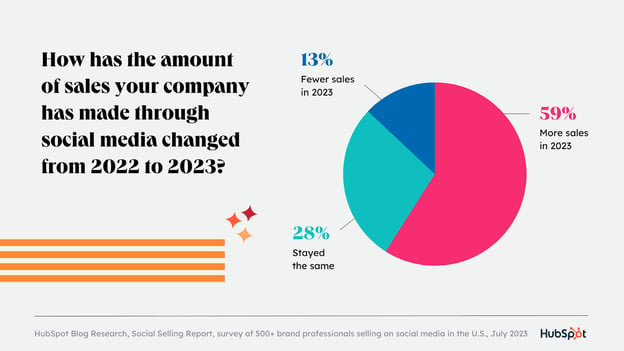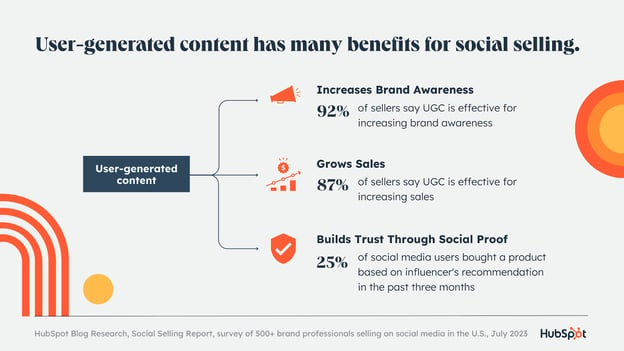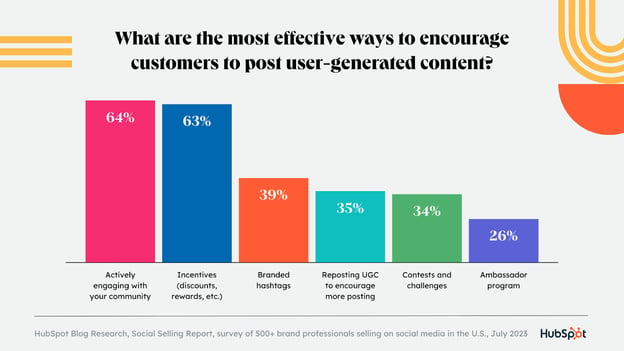Why Social Shopping Could be the Future of E-Commerce [Top Trends & Data from 500+ Social Commerce Pros]
Have you ever gone on social media with the intent of scrolling for entertainment, but left the app with a new purchase?
When I scroll through my TikTok For You page, I come across videos with products that pique my interest, not realizing that the button for me to purchase that item is right above the caption. As a consumer, I love how effortless shopping can now be. But what about businesses — what do they think about social commerce?
To help brands navigate social commerce features and determine if they fit into their strategy, I surveyed 512 social media marketers who leverage social commerce tools like active community engagement and user-generated content to learn if they’ve provided ROI. Here’s what I discovered:
General Trends of Social Selling
Social commerce is a growing channel for both buyers and sellers.
As seen in our Consumer Trends survey, social media is the future of shopping. Within Gen Z, Millennials, and Gen X, social media is the preferred channel for product discovery. Among all consumers, there is a growing number of social media users who buy on social media.
In this survey, 87% of sellers say that social selling has been effective for their business this year. 59% say their company is making more sales through social media this year when compared to last year. Some marketers who sell on multiple channels felt that social media is the best at targeting potential customers and provides one of the best ROI.

Precise audience targeting is a key benefit, in ways beyond advertising.
Over 50% of social sellers mentioned audience reach when asked about the benefits of social selling. They also say that the ability to advertise to your target audience is the most important feature a platform should have, as you can reach markets that would otherwise be untapped.
Paid ads are often the first thought when it comes to targeted advertising. But luckily, social media has more than that. Brands can reach their targeted audience through other pull marketing methods, such as the following:
- UGC: Creators reach a community of people who share similar interests to the creator and would likely be part of the brand’s target audience.
- Word-of-mouth marketing: One-click sharing on social media makes WOM easier, also reaching people with similar interests.
- Active community engagement: Posts with high engagement tend to land on discovery pages, which are tailored to users based on their interests.
Social sellers still diversify where they sell.
Social selling is not seen as a replacement for other channels, but rather, as a complementary channel. 94% of social sellers also sell on another digital channel, such as their own website or a third-party online marketplace.
This is likely because social shops can easily be integrated from e-Commerce websites and connected to third-party online marketplaces. The ease of implementation and high returns of social shops makes it a worthwhile investment.
Sellers struggle to build trust, but UGC can help.
Out of the businesses we surveyed, 3 in 4 repost UGC. 87% say UGC increases their sales, and 92% say it increases brand awareness. Businesses feel strongly about UGC, so we’ll dive a little deeper into why it’s so essential.
In our Consumer Trends surveys, we see that consumers don’t fully trust social shopping. Just 47% of social media users feel comfortable buying through social apps, with the main concern being that companies aren’t legitimate.
Similarly, when we asked social sellers about the challenges of selling on social media, many shared the difficulty of convincing customers to trust their brand/shop. Given that many social shops are smaller businesses and that there’s a rise in both sellers and scammers on social media, building trust is hard.
That brings us to the benefit of incorporating UGC in your selling strategy. Because UGC allows customers to share their personal experiences with products, it acts as social proof that the product is authentic and valuable, with clear use cases.
Social proof guides purchase decisions: one in four social media users bought a product based on an influencer’s recommendation in the past three months. Consumers who find products interesting from UGC can easily reach the brand’s social shop from the UGC post’s tags, and make a purchase.

Sellers can encourage customers to post UGC through active community engagement and incentives.
Within the types of content that brands post on social media, relatable content is the most memorable to consumers.
Simultaneously, there’s been a growth of consumers who now consider themselves content creators. Brands can take advantage of this trust for and growth of content creators by encouraging customers to post their own UGC.
64% of social sellers said that active community engagement is most effective for encouraging customers to repost UGC, with incentives (discounts, rewards, etc.) following as a close second. Sellers have shared how beneficial UGC has been for them, as well. With social media’s vast network, one post can reach and be talked about by many.

Leveraging Inbound Marketing in Social Selling
Social media’s frictionless shopping experience supports the buyer’s journey.
If you’ve ever purchased on social media, you may have noticed how fast the process is.
Here’s an example of how social media features cover the buyer’s journey:
- Awareness: Through push and pull marketing strategies such as targeted advertising, influencer marketing, and word-of-mouth marketing, consumers become aware of a brand’s products and consider learning more.
- Consideration: If a consumer decides to learn more, they can peruse the brand’s profile, which contains a digital storefront, active community, and product reviews. As a community visitor, the consumer may notice the brand’s personality and how brands interact with their community. This may impact purchase intent, as we’ve seen that Gen Z especially values brands that have active communities around them.
- Decision: Now that the consumer has “visited” the brand, they may have questions. These questions can be answered through posts and reviews, or asked through direct messaging. Once the consumer decides to purchase, they can check out in the app.
Throughout this entire process, the consumer never left the social media app. Social selling reduces the friction of traditional e-Commerce, where consumers may do research on social media, purchase on a website, make phone calls for service, and more. Consolidating these tasks into one platform simplifies the shopping process for consumers, increasing customer satisfaction and business sales.
Social selling also supports impulse buying. When asking sellers about social selling benefits, several of them mentioned “impulse purchases.” Because social media is so widely used, someone who meant to scroll for entertainment may be drawn to a product through an ad or UGC post and end up leaving the app with a purchase.
Active community engagement drives social selling success.
45% of social sellers said that the ability to build a community and actively engage with them is the most important feature a social media platform should have when it comes to social selling.
Driving brand communities are the interactions brands have with their followers, who become brand advocates.
As brands keep their customers satisfied post-purchase, they encourage customers to become promoters through methods such as posting new reviews, uploading user-generated content, or sharing the brand with their community with one click of the “share” button.
These promotional strategies align with the previous section’s discussion on strategies for awareness in the buyer’s journey, thus creating a flywheel effect.
.gif?width=768&height=432&name=Social%20Selling%20Blog%20Graphics%20(1).gif)
This effect is also what HubSpot calls inbound marketing: “Once you attain enough customers and delight them, they can keep your flywheel spinning by promoting your organization and bringing new customers to you. Over time, your flywheel allows you to grow without continually investing in customer acquisition.”
Social selling covering the entire flywheel is very powerful because brands can tailor content toward multiple types of customers on one platform and build their customer base faster. With this being said, as a customer, I recommend engaging with smaller brands that you like, as it acts as social proof for prospective customers — uplifting smaller businesses.
Next Steps for Social Media Success
As you consider social selling, spend some time developing your approach toward some of the key drivers for social selling success: audience targeting, brand community engagement, and user-generated content. For more, check out these posts:
- Get started on one of the most popular social selling platforms: How to Sell on Instagram Using Shoppable Posts
- Understand challenges that consumers face with regard to social shopping: Why Consumers Still Hesitate to Shop on Social Media Platforms [New Data]
- Read case studies of how other companies used social commerce tools: How 3 Companies Grew Revenue With Social Media Shopping Tools [New Data + Case Studies]
Lastly, learn more about the other key trends in social media marketing with our free 2023 Social Media Trends Report below.
![]()


![Download Now: The 2023 State of Social Media Trends [Free Report]](https://no-cache.hubspot.com/cta/default/53/3dc1dfd9-2cb4-4498-8c57-19dbb5671820.png)
